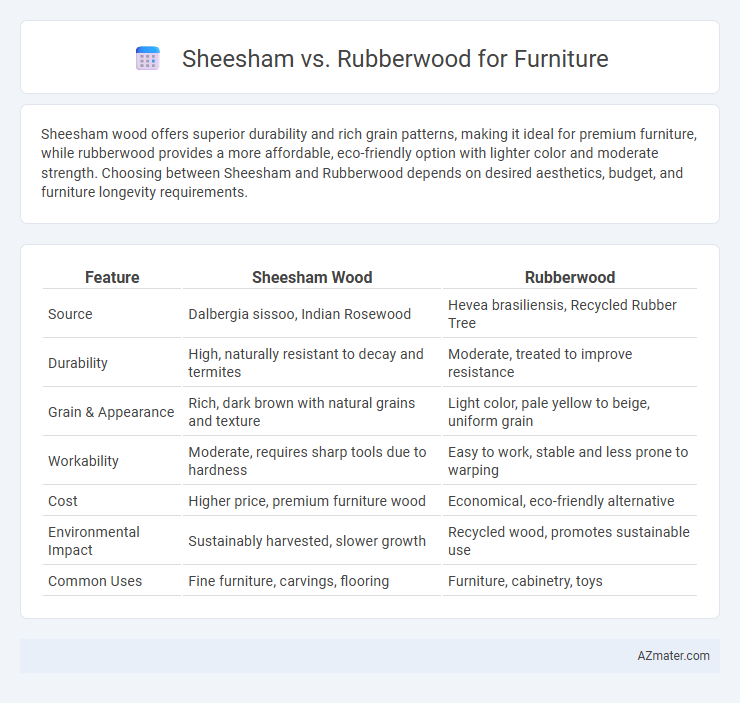Sheesham wood offers superior durability and rich grain patterns, making it ideal for premium furniture, while rubberwood provides a more affordable, eco-friendly option with lighter color and moderate strength. Choosing between Sheesham and Rubberwood depends on desired aesthetics, budget, and furniture longevity requirements.
Table of Comparison
| Feature | Sheesham Wood | Rubberwood |
|---|---|---|
| Source | Dalbergia sissoo, Indian Rosewood | Hevea brasiliensis, Recycled Rubber Tree |
| Durability | High, naturally resistant to decay and termites | Moderate, treated to improve resistance |
| Grain & Appearance | Rich, dark brown with natural grains and texture | Light color, pale yellow to beige, uniform grain |
| Workability | Moderate, requires sharp tools due to hardness | Easy to work, stable and less prone to warping |
| Cost | Higher price, premium furniture wood | Economical, eco-friendly alternative |
| Environmental Impact | Sustainably harvested, slower growth | Recycled wood, promotes sustainable use |
| Common Uses | Fine furniture, carvings, flooring | Furniture, cabinetry, toys |
Introduction to Sheesham and Rubberwood
Sheesham, also known as Indian rosewood, is a dense hardwood prized for its rich grain patterns and durability, making it ideal for high-quality furniture. Rubberwood, sourced from the Para rubber tree, is a sustainable hardwood that offers a lighter color and a more uniform texture, favored for eco-friendly, budget-conscious furniture production. Both woods serve distinct aesthetic and functional purposes, addressing diverse preferences in furniture design and sustainability.
Botanical Origins and Growth Locations
Sheesham, scientifically known as Dalbergia sissoo, is native to the Indian subcontinent and thrives in the foothills of the Himalayas, primarily in India, Pakistan, and Nepal. Rubberwood comes from Hevea brasiliensis, a species native to the Amazon rainforest but widely cultivated in Southeast Asia, particularly in Thailand, Malaysia, and Indonesia, where it is harvested from rubber plantations after latex extraction. The distinct botanical origins influence the density and grain patterns of Sheesham and Rubberwood, affecting their durability and aesthetic appeal in furniture making.
Physical Appearance and Color Variations
Sheesham wood showcases a distinctive grain pattern with rich, dark brown hues and deep golden streaks, offering a luxurious and warm aesthetic for furniture pieces. Rubberwood features a lighter, more uniform pale cream to golden yellow color, often preferred for a modern and clean look. The natural variation in Sheesham's coloration adds character, while Rubberwood's consistent tone allows for easier customization through stains and finishes.
Durability and Strength Comparison
Sheesham wood, also known as Indian rosewood, boasts high durability and natural resistance to decay, making it ideal for long-lasting furniture. Rubberwood, derived from the Paradox rubber tree, offers moderate strength and durability but is more prone to dents and scratches compared to Sheesham. For furniture requiring superior toughness and lifespan, Sheesham is the preferred choice due to its dense grain and robust structural integrity.
Resistance to Pests and Decay
Sheesham wood, also known as Indian rosewood, exhibits strong natural resistance to pests and decay due to its dense grain and natural oils, making it an ideal choice for durable furniture. Rubberwood, derived from the Para rubber tree, is less resistant to fungal attacks and insect infestations unless properly treated with preservatives and finishes. For long-lasting furniture with high resistance to pests and decay, Sheesham is preferable over Rubberwood in terms of natural durability.
Workability and Crafting Differences
Sheesham wood, known for its dense grain and natural oils, offers superior durability and a smooth finish, making it ideal for intricate carving and detailed craftsmanship in furniture. Rubberwood, being lighter and more porous, is easier to machine and shape but requires thorough treatment to enhance durability and prevent moisture damage during crafting. The workability of Sheesham demands skilled artisans due to its hardness, whereas Rubberwood allows for faster production with less wear on tools, influencing choice based on project complexity and longevity requirements.
Environmental Impact and Sustainability
Sheesham wood, also known as Indian rosewood, is a highly durable hardwood harvested from slow-growing trees, often sourced through sustainable forestry practices that promote reforestation and biodiversity. Rubberwood, derived from the Para rubber tree after latex extraction, utilizes plantation trees that are harvested at the end of their latex-producing cycle, making it an eco-friendly choice by repurposing timber that would otherwise be discarded. Both materials offer environmentally conscious options, but rubberwood generally has a lower carbon footprint due to its fast growth and utilization of plantation wood, while Sheesham contributes to sustainable forestry when responsibly managed.
Maintenance and Care Requirements
Sheesham wood requires moderate maintenance, benefiting from regular polishing to enhance its natural luster and prevent dryness, and it is resistant to termite attacks due to its natural oils. Rubberwood demands more frequent care, including regular cleaning and oiling to prevent it from becoming brittle or cracking, as it is less dense and more prone to moisture damage. Both woods should be kept away from excessive humidity and direct sunlight to prolong furniture lifespan and maintain appearance.
Cost and Market Availability
Sheesham wood is generally more expensive than rubberwood due to its durability, rich grain patterns, and slower growth rate, making it a premium choice in furniture markets. Rubberwood, harvested from rubber trees after latex extraction, is more affordable and widely available, appealing to budget-conscious consumers and mass production. Market availability of rubberwood furniture is higher because of its sustainable sourcing and quicker replenishment, whereas Sheesham pieces are often regarded as luxury items with limited stock.
Best Uses: Sheesham vs Rubberwood in Furniture Design
Sheesham, known for its rich grain and natural oils, is ideal for high-end furniture pieces like cabinets and ornate carvings that require durability and aesthetic appeal. Rubberwood, with its lighter, uniform texture and affordability, is best suited for mass-produced furniture such as chairs, tables, and shelving that benefit from easy finishing and eco-friendly sourcing. Choosing Sheesham enhances traditional, long-lasting furniture designs, while Rubberwood excels in modern, budget-conscious projects with versatile applications.

Infographic: Sheesham vs Rubberwood for Furniture
 azmater.com
azmater.com